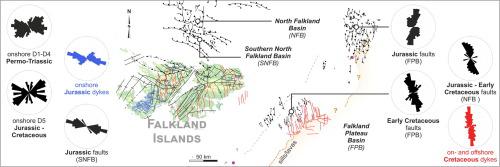Gondwana Research ( IF 6.1 ) Pub Date : 2021-10-05 , DOI: 10.1016/j.gr.2021.09.014 Roxana M. Stanca 1 , Dave J. McCarthy 2 , Douglas A. Paton 3 , David M. Hodgson 1 , Estelle J. Mortimer 1

|
Commonly, intra-continental wrenching is associated with a high degree of crustal faulting and fragmentation. The resulting continental blocks can undergo vertical-axis rotations, which in turn can lead to the generation of intricate fault networks within and along their boundary regions. Investigations into these structural complexities can support understanding of when and how these continental blocks rotate, and what their position was prior to transform margin formation. In the case of the Falkland Islands Microplate (part of the Falkland Plateau transform margin), its position between South Africa, South America, and East Antarctica prior to the break-up of Gondwana is still debatable. This uncertainty affects the reliability of plate models for this region. Here we integrate gravity and 2D and 3D seismic reflection data from the eastern margin of the microplate (west side of the Falkland Plateau Basin) to provide insights into the tectono-stratigraphic architecture of this area from Jurassic onwards, and into the evolution of the Falkland Islands Microplate. Our findings show that the western part of the Falkland Plateau Basin is an integral part of the microplate, and it underwent deformation in a relatively fast-changing stress regime. Stress field configuration estimates across the Falkland Islands Microplate support an alternation between a NE-SW and NW-SE/WNW-ESE orientation of σ3 during the Jurassic and an ENE-WSW oriented σ3 during the Lower Cretaceous. Correlations of this local stress configuration with the regional support a Middle to Upper Jurassic rotation of the microplate in a predominantly extensional setting facilitated by the early fragmentation of south-western Gondwana.
中文翻译:

福克兰高原盆地构造地层结构;对福克兰群岛微板块演化的影响
通常,大陆内扭曲与高度的地壳断裂和破碎有关。由此产生的大陆块可以进行垂直轴旋转,这反过来又会导致在其边界区域内和沿其产生复杂的断层网络。对这些结构复杂性的调查可以帮助理解这些大陆块何时以及如何旋转,以及它们在转换边缘形成之前的位置。就福克兰群岛微板块(福克兰高原变换边缘的一部分)而言,它在冈瓦纳大陆分裂之前位于南非、南美洲和南极东部之间的位置仍存在争议。这种不确定性会影响该地区板块模型的可靠性。在这里,我们整合了来自微板块东缘(福克兰高原盆地西侧)的重力和 2D 和 3D 地震反射数据,以深入了解该地区自侏罗纪以来的构造地层结构,以及福克兰的演化岛屿微孔板。我们的研究结果表明,福克兰高原盆地西部是微板块的一个组成部分,它在相对快速变化的应力状态下发生变形。整个福克兰群岛微板块的应力场配置估计支持 σ 的 NE-SW 和 NW-SE/WNW-ESE 方向之间的交替 我们的研究结果表明,福克兰高原盆地西部是微板块的一个组成部分,它在相对快速变化的应力状态下发生变形。整个福克兰群岛微板块的应力场配置估计支持 σ 的 NE-SW 和 NW-SE/WNW-ESE 方向之间的交替 我们的研究结果表明,福克兰高原盆地西部是微板块的一个组成部分,它在相对快速变化的应力状态下发生变形。整个福克兰群岛微板块的应力场配置估计支持 σ 的 NE-SW 和 NW-SE/WNW-ESE 方向之间的交替3侏罗纪和 ENE-WSW 取向 σ 3在下白垩纪。这种局部应力配置与区域的相关性支持微板块在主要伸展环境中的中至上侏罗纪旋转,这是由冈瓦纳西南部的早期破碎促进的。



























 京公网安备 11010802027423号
京公网安备 11010802027423号